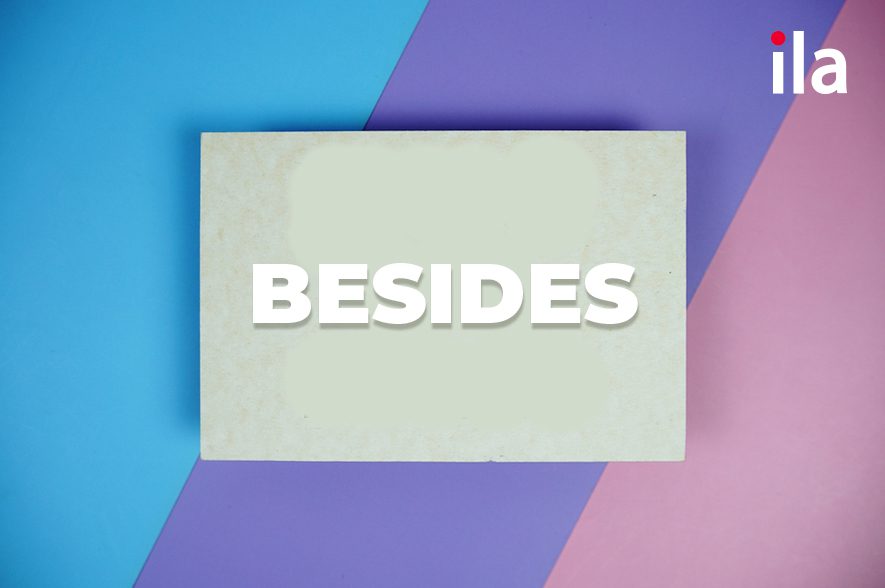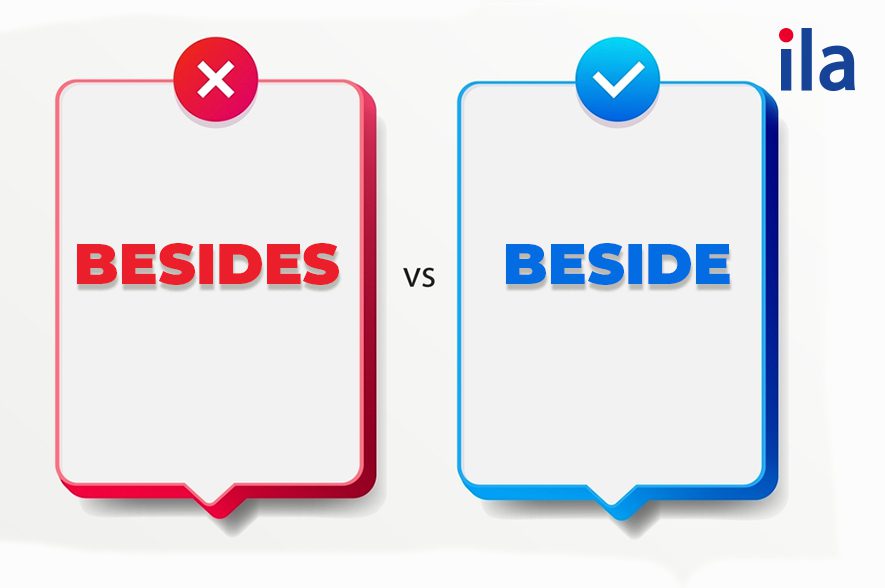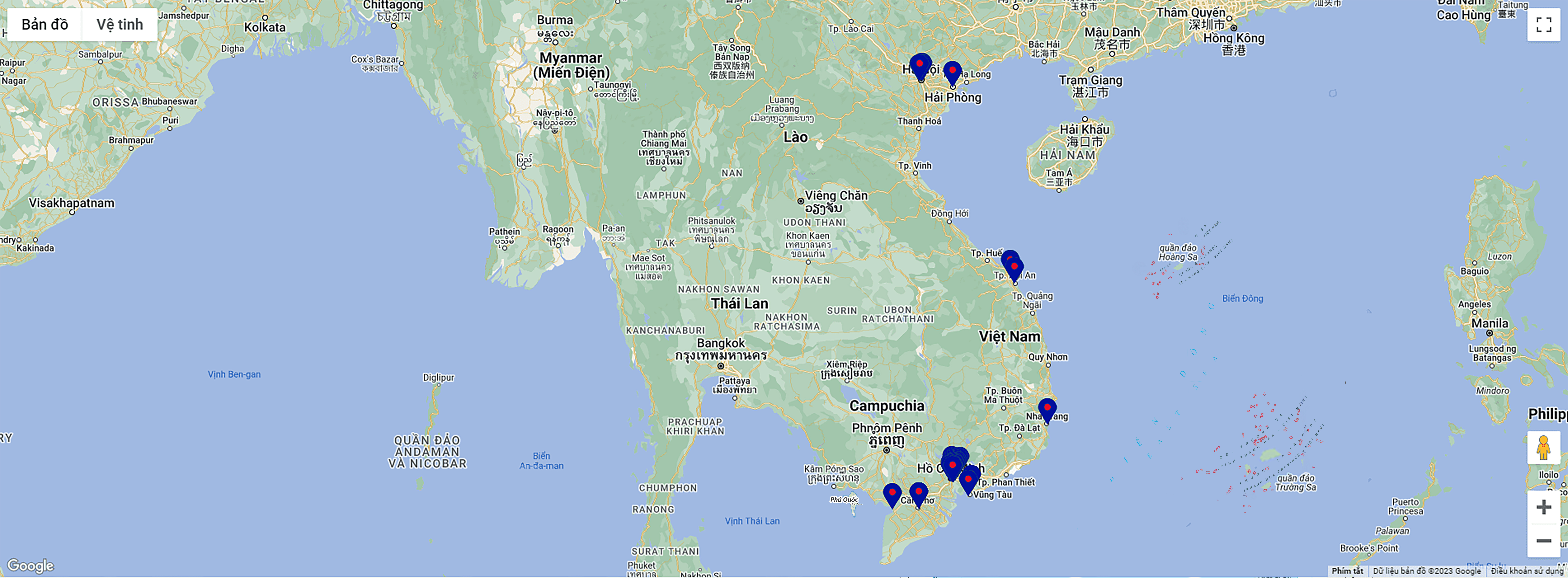Bạn thường nhầm lẫn trong cách dùng beside và besides? Trong bài viết này, ILA sẽ giúp bạn hiểu rõ beside là gì, cũng như mẹo phân biệt beside và besides chi tiết qua từng ví dụ cụ thể.
Beside là gì?
Beside (phiên âm là /bɪˈsaɪd/) có nghĩa tương tự như near, close to hoặc next to – tức là “gần” hoặc “bên cạnh”. Beside đóng vai trò như một giới từ (preposition) chỉ vị trí một người hoặc vật ở bên cạnh một người hoặc vật khác. Ngoài ra, beside có thể được dùng để so sánh.
Như vậy, bạn sẽ có cấu trúc: Beside + Danh từ (Noun)
Ví dụ:
• Your shoes are beside the closet. (Giày của bạn ở bên cạnh tủ quần áo.)
• Place the utensils beside the plates. (Đặt đồ dùng bên cạnh đĩa.)
• Please stand beside me, not in front of me. (Xin hãy đứng cạnh tôi, đừng đứng trước mặt tôi.)
• I wish to sit beside Lisa and take a picture with her. (Tôi ước gì được ngồi cạnh Lisa và chụp ảnh với cô ấy.)
• My artwork looks silly beside yours. (Tác phẩm nghệ thuật của tôi trông thật ngớ ngẩn khi so sánh với tác phẩm của bạn.)
• Her car looks tiny beside his truck. (Chiếc xe của cô ấy trông thật nhỏ bé khi đứng cạnh chiếc xe tải của anh ấy.)
• The phone seems old beside the new one. (Chiếc điện thoại trông cũ kỹ khi đặt cạnh chiếc điện thoại mới.)
>>> Tìm hiểu thêm: Mạo từ xác định: tránh mắc lỗi khi dùng trong tiếng Anh
Besides là gì?
Besides (phiên âm /bɪˈsaɪdz/) được hình thành từ “beside” thêm “s” và có hai cách sử dụng. Nó có thể đóng vai trò là một giới từ (preposition) hoặc một trạng từ (adverb) tùy theo ngữ cảnh.
a. Besides là giới từ
Besides có nghĩa là “ngoài ra”, “khác với” hoặc “ngoại trừ”.
Bạn sẽ có cấu trúc: Besides + Danh từ (Noun)
Ví dụ:
• Let’s do something else besides that. (Chúng ta hãy làm điều gì khác ngoài điều đó.)
• Besides our taste in music, we really have nothing in common. (Ngoài sở thích âm nhạc, chúng tôi thực sự không có điểm chung nào.)
• There was no one at the theater besides us. (Không có ai ở rạp hát ngoài chúng tôi.)
• Besides Lucy, who else has not completed their project? (Ngoài Lucy, còn ai chưa hoàn thành dự án của họ nữa?)
b. Besides là trạng từ
Besides có nghĩa tương tự “furthermore” (hơn nữa, vả lại, ngoài ra) hoặc “moreover” (hơn thế nữa, thêm vào đó). Besides được dùng để thêm thông tin vào một câu và có dấu phẩy (,) theo sau.
Bạn sẽ có cấu trúc: Besides + Mệnh đề (Clause)
Ví dụ:
• I don’t want to go, and besides, the shop is closed. (Tôi không muốn đi, hơn nữa, cửa hàng cũng đóng cửa rồi.)
• I’m not hungry. Besides, I don’t like the food they serve here. (Tôi không đói. Ngoài ra, tôi không thích đồ ăn họ phục vụ ở đây.)
• She is too tired to go for practice. Besides, she has hurt her knees. (Cô ấy quá mệt để đi tập luyện. Hơn nữa, cô ấy còn bị đau đầu gối.)
• He wishes to learn more. Besides, he is a competitive person. (Anh ấy muốn học thêm. Hơn nữa, anh ấy là người có tính cạnh tranh.)
>>> Tìm hiểu thêm: Bài tập liên từ: Tổng hợp các dạng bài bạn cần biết
Cách phân biệt besides và beside là gì?
1. Phân biệt cách dùng beside và besides
Hiểu rõ sự khác biệt giữa besides và beside là gì sẽ giúp bạn sử dụng các cấu trúc này một cách chính xác trong giao tiếp và bài viết tiếng Anh. Mẹo ghi nhớ nhanh đó là:
• Cách sử dụng: Beside là giới từ chỉ sự gần gũi về mặt vật lý. Trong khi besides có thể là giới từ hoặc trạng từ chỉ sự bổ sung hoặc ngoại lệ. Việc liên kết từng từ với chức năng của nó sẽ giúp bạn sử dụng chúng một cách chính xác.
• Vị trí câu: Beside thường xuất hiện ở giữa câu. Ngược lại, besides có thể xuất hiện ở bất cứ đâu.
2. Trường hợp đặc biệt của beside là gì?
a. To be beside the point
Đôi khi, bạn sẽ bắt gặp cụm từ “to be beside the point”. Đây là thành ngữ mô tả một cái gì đó không quan trọng hoặc không liên quan đến những gì đang được thảo luận. Bạn không thể thay thế beside bằng besides.
Ví dụ:
• Đúng: He brought up the cost, but that’s beside the point. (Ông ấy có nêu ra chi phí nhưng đó không phải là vấn đề chính).
• Sai: He brought up the cost, but that’s besides the point.
b. To be beside oneself
“To be beside oneself” là một cụm từ mô tả một người nào đó đang cảm thấy có những cảm xúc mãnh liệt. Cụm từ này có thể thay đổi tùy theo chủ ngữ (beside myself, beside herself, beside themselves…)
Ví dụ:
• He was beside himself with joy when he heard the good news. (Anh ấy đã rất vui mừng khi nghe tin tốt lành.)
• Jenny was beside herself with anger when she heard about the injustice. (Jenny đã rất tức giận khi nghe về sự bất công.)
>>> Tìm hiểu thêm: 50+ câu nói truyền cảm hứng tiếng Anh tạo động lực ngay lập tức
Bài tập luyện tập cách dùng beside và besides
Bài tập 1: Chọn đáp án đúng nhất.
1. Which of the following is a correct definition of beside?
A. As well as
B. In addition to
C. Except
D. Close to
2. Which of the following is a correct definition of besides?
A. Near
B. Next to
C. Furthermore
D. Unimportant
3. Which sentence is written correctly?
A. My pet dog is happy sitting besides me.
B. Isabel is beside herself with excitement.
C. Beside going to the gym, we might also see a movie.
D. She has a lot of free time, but that’s besides the point.
4. Which of the following is written incorrectly?
A. Beside me, there’s no one else here.
B. Who is the girl walking beside Julia?
C. Besides being hungry, I’m also a little thirsty.
D. What do you want to do besides going to the gym?
Đáp án bài tập beside là gì:
1. D
2. C
3. B
4. A
Bài tập 2: Chọn đáp án đúng nhất.
1. __________ Sophie and Kate, there was hardly anyone else in the movie theater.
A. Besides (used to mean except for)
B. Besides (used to mean in addition to)
C. Beside (used to mean next to or near)
D. Beside (used to mean other than)
2. Kim feels extremely happy. She is __________
A. Besides with happiness.
B. Besides herself with happiness.
C. Beside with happiness.
D. Beside herself with happiness.
3. Sophie often sits on the sofa __________ her brother. __________ being fun to talk to, he can help her with her homework.
A. Beside; beside
B. Besides; besides
C. Beside; besides
D. Besides; beside
4. I know you didn’t mean to lose your keys, but __________
A. That’s beside the point.
B. This is besides the point.
C. You’re beside the point.
D. It’s besides the point.
Đáp án:
1. A
2. D
3. C
4. A
>>> Tìm hiểu thêm: Bài tập chia động từ trong tiếng Anh (Có đáp án)
Bài tập 3: Điền beside hoặc besides vào ô trống.
1. I also like to sit ________________________ my best friend.
2. _______________ my best friend, I have a couple of other friends in class.
3. I was _______________ myself with joy when I learned my best friend was in the class.
4. I was _______________ myself with disappointment when I learned my best friend dropped the class.
5. I have completed all of my general education requirements _________________ physical science.
6. It is easy for me to study because my dormitory is right _____________ the library.
7. And after I study, I can go eat because the cafeteria is _________ the library on the other side.
8. And after I eat, it is easy for me to workout because the gym is _________________ the cafeteria.
9. __________ the library, I also like to study outside on the green when it is warm outside.
10. _______________ my roommate, she is my closest friend at the university.
Đáp án bài tập beside là gì:
1. Beside
2. Besides
3. Beside
4. Beside
5. Besides
6. Beside
7. Beside
8. Beside
9. Besides
10. Besides
Bài tập 4: Áp dụng cách dùng beside và besides để điền từ đúng vào ô trống.
Mrs. Shaw takes the number 10 bus home from work every day. (1)__________ being convenient, it’s an inexpensive way to travel around the city. Mrs. Shaw usually sits at the front, and tries to get a seat (2) __________ the window. Sometimes she runs into one of her friends, who comes and sits (3)__________ her. (4)__________ Mrs. Shaw and her friend, there usually aren’t very many people on the bus.
One day, Mrs. Shaw realized that she had lost her bag. She thought she might have left it on the bus, but she couldn’t remember if she put it on the seat (5)__________ her, or on the floor(6)__________ her feet. Mrs. Shaw was (7)__________ herself with worry. (8)__________ her wallet, her cell phone and house keys were in the bag. She just did not know what to do. She didn’t have a lot of money in her wallet, but that was (9)__________ the point.
Luckily, when Mrs. Shaw got home, Mr. Shaw was already there. Mrs. Shaw had indeed left her bag on the bus, right at the front (10)__________ the driver’s seat. The bus driver had called about 15 minutes before to say that he found it. He was able to recognize the bag, because (11)__________ being an unusual color, it had a distinctive pattern. When she learned this, Mrs. Shaw was (12)__________ herself with joy. She decided to buy a gift for the bus driver to say thank you. (13)__________ a thank you note, she bought him a homemade cake.
Đáp án:
1. Besides
2. Beside
3. Beside
4. Besides
5. Beside
6. Beside
7. Beside
8. Besides
9. Beside
10. Beside
11. Besides
12. Beside
13. Besides
Hy vọng bài viết của ILA đã giúp bạn hiểu rõ beside là gì cũng như phân biệt beside và besides. Chúc bạn sẽ áp dụng hiệu quả vào quá trình học tiếng Anh.
>>> Tìm hiểu thêm: Khám phá tên tiếng Anh của 12 cung hoàng đạo








